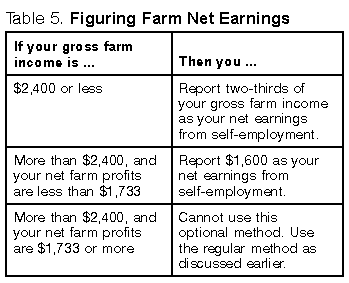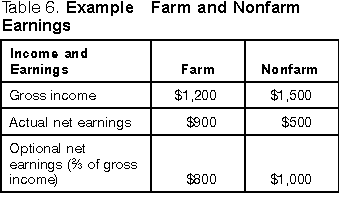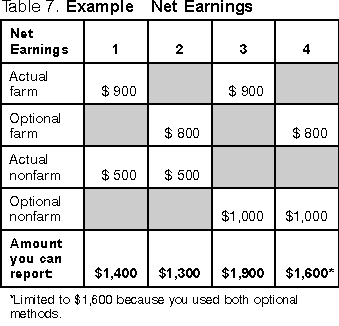There are three ways to figure your net earnings from
self-employment.
- The regular method.
- The nonfarm optional method.
- The farm optional method.
Which Method Should You Use?
You must use the regular method unless you are eligible to use one
or both of the optional methods. (See Table 3.)
Why use an optional method?
You may want to use the optional methods (discussed later) when you
have a loss or a small net profit and any one of the following
applies.
- You want to receive credit for social security benefit
coverage.
- You incurred child or dependent care expenses for which you
could claim a credit. (An optional method may increase your earned
income, which could increase your credit.)
- You are entitled to the earned income credit. (An optional
method may increase your earned income, which could increase your
credit.)
Table 3. Can I Use the Optional Methods?
Effects of using an optional method.
Using an optional method could increase your SE tax. Paying more SE
tax can result in your getting higher benefits when you retire.
If you use either or both optional methods, you must figure and pay
the SE tax due under these methods even if you would have had a
smaller tax or no tax using the regular method.
The optional methods may be used only to figure your SE tax. To
figure your income tax, include your actual earnings in gross income,
regardless of which method you use to determine SE tax.
Regular Method
Multiply your total earnings subject to SE tax by 92.35% (.9235) to
get your net earnings under the regular method. See Short
Schedule SE , line 4, or Long Schedule SE , line 4a.
Net earnings figured using the regular method are also called
actual net earnings.
Nonfarm Optional Method
Use the nonfarm optional method only for earnings that do not come
from farming. You may use this method if you meet all the following
tests.
- You are self-employed on a regular basis. This means that
your actual net earnings from self-employment were $400 or more in at
least 2 of the 3 tax years before the one for which you use this
method. The net earnings can be from either farm or nonfarm earnings
or both.
- You have not previously used this method more than 4 years.
(There is a 5-year lifetime limit.) The years do not have to be one
after another.
- Your net nonfarm profits were:
- Less than $1,733, and
- Less than 72.189% of your gross nonfarm income.
Net nonfarm profits.
Net nonfarm profits generally is the total of the amounts from:
- Line 31, Schedule C (Form 1040),
- Line 3, Schedule C-EZ (Form 1040),
- Line 15a, Schedule K-1 (Form 1065), (from nonfarm
partnerships), and
- Box 9, Schedule K-1 (Form 1065-B), (look for
code K1).
However, you may need to adjust the amount reported on
Schedule K-1 if you are a general partner or if it is a loss.
For more information, see Partnership Income or Loss,
earlier.
Gross nonfarm income.
Your gross nonfarm income generally is the total of the amounts
from:
- Line 7, Schedule C (Form 1040),
- Line 1, Schedule C-EZ (Form 1040),
- Line 15c, Schedule K-1 (Form 1065), (from nonfarm
partnerships), and
- Box 9, Schedule K-1 (Form 1065-B), (look for
code K2).
Figuring Nonfarm Net Earnings
If you meet the three tests explained earlier, use the following
table to figure your net earnings from self-employment under the
nonfarm optional method.
Table 4. Figuring Nonfarm
Net Earnings
| If your gross nonfarm income is ... |
Then your net earnings are equal to ... |
| $2,400 or less |
The greater of:
- Two-thirds of your gross nonfarm income, or
- Actual net earnings.
|
| More than $2,400 |
The greater of:
- $1,600, or
- Actual net earnings.
|
Optional earnings less than actual earnings.
You cannot use this method to report an amount less than your
actual net earnings from self-employment. Your actual net earnings are
your net earnings figured using the regular method, explained earlier.
Gross income of $2,400 or less.
The following examples illustrate how to figure net earnings when
gross nonfarm income is $2,400 or less.
Example 1--net nonfarm profit less than $1,733 and less
than 72.189% of gross nonfarm income.
Ann Green runs a craft business. Her actual net earnings from
self-employment were $800 in 1999 and $900 in 2000. She meets the test
for being self-employed on a regular basis. She has not previously
used the nonfarm optional method for more than 4 years. Her gross
income and net profit in 2001 are as follows:
| Gross income |
$2,100 |
| Net profit |
$1,200 |
Ann's actual net earnings for 2001 are $1,108 ($1,200 ×
.9235). Because her net profit is less than $1,733 and less than
72.189% of her gross income, she can use the nonfarm optional method
to figure net earnings of $1,400 ( 2/3 × $2,100).
Because these net earnings are higher than her actual net earnings,
she can report net earnings of $1,400 for 2001.
Example 2--net nonfarm profit less than $1,733 but not
less than 72.189% of gross nonfarm income.
Assume that in Example 1 Ann's gross income is $1,000
and her net profit is $800. She must use the regular method to figure
her net earnings. She cannot use the nonfarm optional method because
her net profit is not less than 72.189% of her gross income.
Example 3--net loss from a nonfarm business.
Assume that in Example 1 Ann has a net loss of $700. She
can use the nonfarm optional method and report $1,400 ( 2/3 × $2,100) as her net earnings.
Example 4--net earnings less than $400.
Assume that in Example 1 Ann has gross income of $525
and a net profit of $175. In this situation, she would not pay any SE
tax under either the regular method or the nonfarm optional method
because her net earnings under both methods are less than $400.
Gross income of more than $2,400.
The following examples illustrate how to figure net earnings when
gross nonfarm income is more than $2,400.
Example 1--net nonfarm profit less than $1,733 and less
than 72.189% of gross nonfarm income.
John White runs an appliance repair shop. His actual net earnings
from self-employment were $10,500 in 1999 and $9,500 in 2000. He meets
the test for being self-employed on a regular basis. He has not
previously used the nonfarm optional method for more than 4 years. His
gross income and net profit in 2001 are as follows:
| Gross income |
$12,000 |
| Net profit |
$1,200 |
John's actual net earnings for 2001 are $1,108 ($1,200 ×
.9235). Because his net profit is less than $1,733 and less than
72.189% of his gross income, he can use the nonfarm optional method to
figure net earnings of $1,600. Because these net earnings are higher
than his actual net earnings, he can report net earnings of $1,600 for
2001.
Example 2--net nonfarm profit not less than $1,733.
Assume that in Example 1 John's net profit is $1,800. He
must use the regular method. He cannot use the nonfarm optional method
because his net nonfarm profit is not less than $1,733.
Example 3--net loss from a nonfarm business.
Assume that in Example 1 John has a net loss of $700. He
can use the nonfarm optional method and report $1,600 as his net
earnings from self-employment.
Farm Optional Method
Use the farm optional method only for earnings from a farming
business. You can use this method if you meet either of the following
tests.
- Your gross farm income is $2,400 or less.
- Your net farm profits are less than $1,733.
Gross farm income.
Your gross farm income is the total of the amounts from:
- Line 11, Schedule F (Form 1040), and
- Line 15b, Schedule K-1 (Form 1065), (from farm
partnerships).
Net farm profits.
Net farm profits generally is the total of the amounts from:
- Line 36, Schedule F (Form 1040), and
- Line 15a, Schedule K-1 (Form 1065), (from farm
partnerships).
However, you may need to adjust the amount reported on Schedule
K-1 if you are a general partner or if it is a loss. For more
information, see Partnership Income or Loss, earlier.
Figuring Farm Net Earnings
If you meet either of the two tests explained earlier, use the
following table to figure your net earnings from self-employment under
the farm optional method.

Optional earnings less than actual earnings.
If your farm net earnings are less than your actual net earnings,
you can still use the farm optional method. Your actual net earnings
are your net earnings figured using the regular method, explained
earlier.
Example.
Your actual net earnings from self-employment are $425 and your net
earnings figured under the farm optional method are $390. You owe no
SE tax if you use the optional method because your net earnings under
the farm optional method are less than $400.
Using Both Optional Methods
If you have both farm and nonfarm earnings, you may be able to use
both optional methods to determine your net earnings from
self-employment.
To figure your net earnings using both optional methods, you must:
- Figure your farm and nonfarm earnings separately under each
method. Do not combine farm earnings with nonfarm earnings
to figure your net earnings under either method.
- Add the net earnings figured under each method to arrive at
your total net earnings from self-employment.
You can report less than your total actual farm and nonfarm net
earnings but not less than actual nonfarm net earnings. If you use
both optional methods, you can report no more than $1,600 as your
combined net earnings from self-employment.
Example.
You are a self-employed farmer. You also operate a retail grocery
store. Your gross income, actual net earnings from self-employment,
and optional farm and optional nonfarm net earnings from
self-employment are as follows:

You can figure your net earnings from self-employment in any of the
four combinations shown below:

Previous | First | Next
Publication Index | 2001 Tax Help Archives | Tax Help Archives | Home
